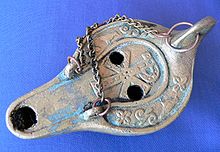
Back مصباح زيتي Arabic ܫܪܓܐ ܕܢܦܛܐ ARC Каганец Byelorussian Каганец BE-X-OLD Маслена лампа Bulgarian কূপি Bengali/Bangla Llàntia Catalan Olielampe Danish Öllampe German Olelampo Esperanto






An oil lamp is a lamp used to produce light continuously for a period of time using an oil-based fuel source. The use of oil lamps began thousands of years ago and continues to this day, although their use is less common in modern times. They work in the same way as a candle but with fuel that is liquid at room temperature, so that a container for the oil is required. A textile wick drops down into the oil, and is lit at the end, burning the oil as it is drawn up the wick.
Oil lamps are a form of lighting, and were used as an alternative to candles before the use of electric lights. Starting in 1780, the Argand lamp quickly replaced other oil lamps still in their basic ancient form. These in turn were replaced by the kerosene lamp in about 1850. In small towns and rural areas the latter continued in use well into the 20th century, until such areas were finally electrified and light bulbs could be used.
Sources of fuel for oil lamps include a wide variety of plants such as nuts (walnuts, almonds and kukui) and seeds (sesame, olive, castor, or flax). Also widely used were animal fats (butter, ghee, fish oil, shark liver, whale blubber, or seal). Camphine, made of purified spirits of turpentine, and burning fluid, a mixture of turpentine and alcohol, were sold as lamp fuels starting in the 1830s as the whale oil industry declined. Burning fluid became more expensive during the Civil War when a federal tax on alcohol was reenacted.[1][2] Sales of both camphene and burning fluid decreased in the late 1800s as other sources of lighting, such as kerosene made from petroleum, gas lighting and electric lighting, began to predominate.
Most modern lamps (such as fueled lanterns) have been replaced by gas-based or petroleum-based fuels to operate when emergency non-electric light is required. Oil lamps are currently used primarily for their ambience.
- ^ Veach, Michael R. "Whiskey Taxation, Part Two: The American Civil War And Beyond". Bourbon History. Bourbon Veach LLC. Retrieved 23 March 2024.
- ^ Edwards, Phil (August 7, 2015). "The horrific spike in whiskey prices during the Civil War, in one chart". Vox Media. Retrieved 15 March 2024.
© MMXXIII Rich X Search. We shall prevail. All rights reserved. Rich X Search